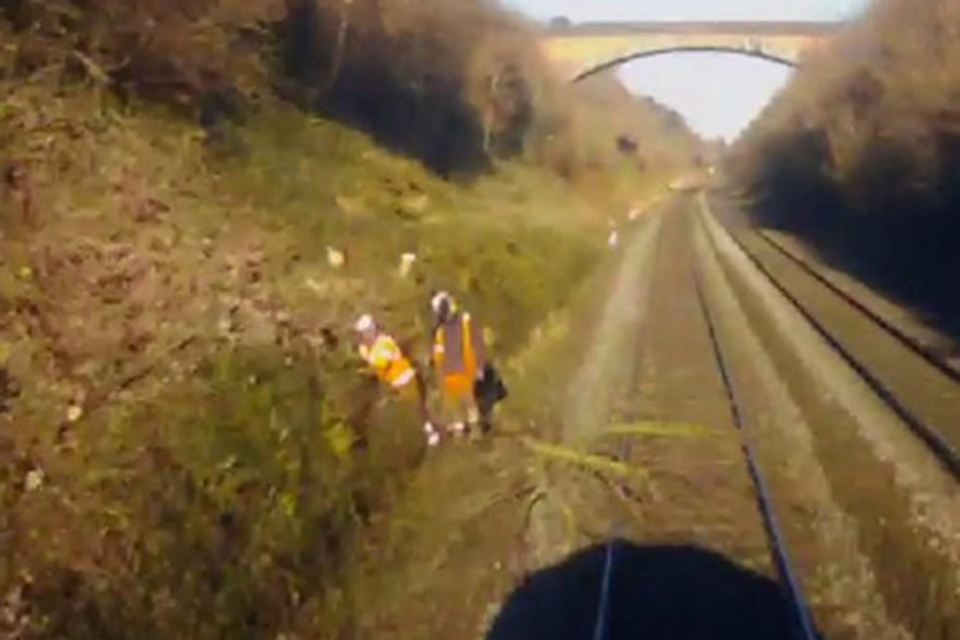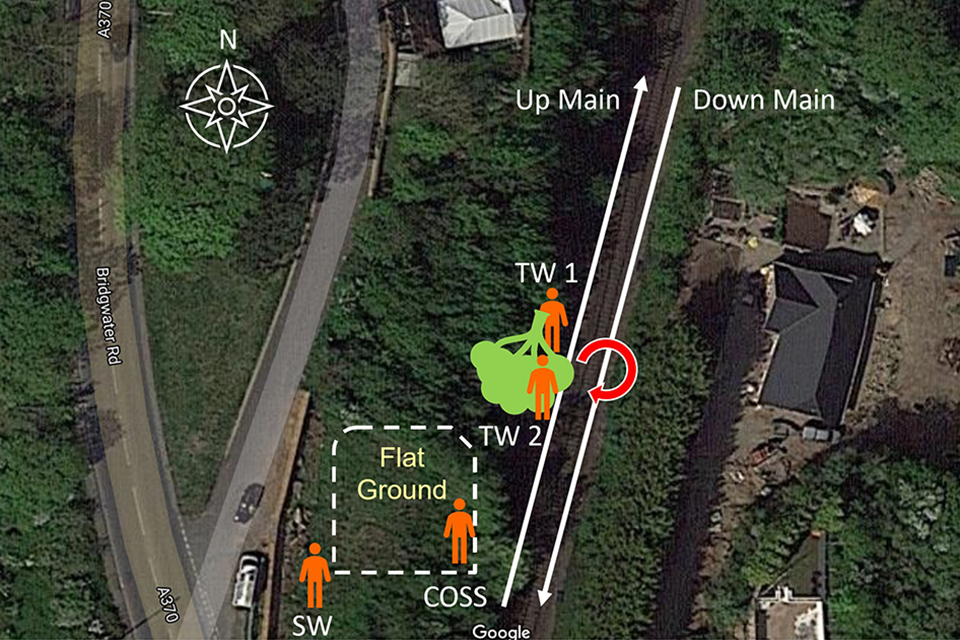Near miss with track workers and collision with a tree on the line at Uphill Junction, 14 January 2022
Published 16 May 2022
1. Important safety messages
This incident demonstrates the importance of:
-
Staff undertaking vegetation management in the vicinity of railway lines being aware of the risks that the felling or trimming of trees may pose to trains, and ensuring that any required control measures are implemented in line with the relevant rules and instructions
-
Those responsible for leading teams working within the railway boundary ensuring that they effectively control their team’s activities and implement and maintain the required control measures both in normal and unexpected circumstances
-
Organisations working within the railway boundary clearly communicating an appropriate and safe method of work to staff carrying out work which may affect the safety of the line
2. Summary of the incident
At around 13:10 hrs on Friday 14 January 2022, train reporting number 1S49, the 09:25 hrs CrossCountry service from Penzance to Newcastle, was travelling at 95 mph (153 km/h) when it narrowly missed two track workers and struck a tree which was foul of the line. The incident occurred at Uphill Junction, approximately 2 miles (3.2 km) to the south-east of Weston-super-Mare, on the section of line between Highbridge & Burnham and Worle.
The track workers, who were undertaking de-vegetation work, had previously felled the tree on the slope of the cutting next to the railway, before it unexpectedly dropped into the cess. They immediately followed the tree down the slope and into the cess with the intention of moving it to a safe area away from the line. Once they reached the cess, they were in a position close to the adjacent open line without any protection from moving trains in place. While attempting to position the tree to allow for easier removal, they entered the space between the rails (an area known as the four-foot) and pulled the tree across the open line.
The train involved left Taunton at 12:54 hrs and was travelling near to the 100 mph (160 km/h) maximum permitted line speed when the driver observed track workers on the line ahead. The driver sounded the train’s horn approximately 10 seconds before reaching the track workers with the expectation that they would move to a position of safety, where it would be safe to stand as the train passed. The track workers, however, did not acknowledge the warning, or move off the line, so the driver sounded the horn for a second time and applied the train’s brakes. The track workers became aware of the presence of the train after warnings being shouted by the Controller of Site Safety (COSS), who stated that he had been attempting to call the signaller when the train approached. The track workers moved to the cess and clear of the line approximately 2 seconds before the arrival of the train, which then struck the tree. Although the track workers were close to the tree at the time of collision, nobody was injured.
After the train came to a stop, the driver contacted the signaller to report the incident. The driver then examined his train and discovered that it had sustained minor damage but was able to continue to the next planned stopping point, Bristol Temple Meads.

Still image taken from the train’s forward-facing CCTV showing the position of the track workers and the tree foul of the line shortly before the train struck the tree (image courtesy of CrossCountry).
3. Cause of the incident
QTS Group were operating as Network Rail’s principal contractor for a package of vegetation removal works over a 25 mile stretch of line in the Uphill Junction area, scheduled to run from May 2021 to April 2022. The track workers involved were undertaking de-vegetation work as part of this package.
The team consisted of four individuals. These were: the COSS (a person certified as competent to establish and maintain a safe system of work), who was also the QTS supervisor and Person-in-Charge (PIC, the person with overall accountability for supervising and overseeing safe implementation of the work); a site warden, also employed by QTS; and two chainsaw operators (track worker 1 and track worker 2) who were self-employed sub-contractors.
The de-vegetation task required the team to work within the railway boundary adjacent to a line which was open. The area within 3 metres of the nearest running rail is classed as being ‘on or near the line’ by railway rules. Under the planned safe system of work, staff were required to have a site warden in position when on or near the line to ensure they did not leave their site of work and get closer than 2 metres to the open line (the designated position of safety for lines on which trains can approach at 100 mph (160 km/h) or over).
GE/RT 8000 The Rule Book, Handbook 7, Issue 8, 4 December 2021 ‘General duties of a controller of site safety (COSS)’ states that ‘felling or trimming trees’ is an activity which affects the safety of the line and that the COSS should not allow this work to take place unless the line is blocked, or this work is ‘specifically allowed in your company instructions’.
The company instructions provided by QTS gave inconsistent advice on whether a securing rope should be used to control the fall of vegetation. Some of the documents and risk assessments mandated the use of ropes, whereas others allowed the site team to apply their discretion as to the use of ropes. QTS has explained that the divergence of instructions within these documents is to allow for site decision making based on the size of the tree being felled. However, the QTS site decision-making tool does not provide specific parameters to assist site supervisors deciding on when felling aids should be used.
The tree which was struck by the train was an ash which was between 3 and 4 metres tall. The tree was growing 3.2 metres away from the adjacent line, meaning it was located within its own length from the nearest running rail. As such, the tree was defined as a ‘red’ category tree by the QTS ‘red, amber, green’ decision-making tool. This required track workers 1 and 2 to apply a methodology agreed with the COSS and to be directly supervised by a QTS supervisor when felling the tree (in this case the COSS was also undertaking the role of QTS supervisor).
The risk assessment in use at the time of the incident mandated a circular exclusion zone with a radius of two tree lengths. The site task brief explains that this exclusion zone is to be ‘identified and maintained for all operations including third parties and members of the public’. QTS stated that this was intended to mitigate the risk of a tree falling on a person and was not intended to exclude trains travelling through such a zone on an adjacent open line.
The team were briefed on the work package plan between 12 and 14 January and received a further brief on the safe system of work from the COSS on the morning of 14 January, prior to starting work. Following this briefing, the team started work. By 13:00 hrs, the team had felled 24 saplings and had one final task to complete before finishing for the day, which was to fell the tree involved in the incident. The tree had a diameter of 165 mm where it was cut and the relevant Network Rail standard considers trees or branches with a diameter of 150 mm or greater as capable of causing derailments.
Throughout the day, the COSS had implemented a safe system of work in which he appointed the site warden based on the proximity of the work to the open line. As the tree to be felled was situated 3.2 metres from the nearest running rail, the COSS had stood down the site warden prior to it being cut down. The site warden then temporarily left the site of work for a break.
There is conflicting witness evidence on whether the COSS directly supervised the felling of the tree, but all involved in the work agreed that the tree was not secured with a rope as it was felled. Witness evidence also suggests that track worker 2 was within the two tree length exclusion zone at the time track worker 1 was felling the tree, so as to be ready to push the tree up the slope, in lieu of using a rope to control it. As well as being in the exclusion zone, the position of track worker 2 during the tree felling was close enough to the running line that the site warden should have been in position. On seeing the tree fall into the cess and track workers 1 and 2 following it down the slope, the COSS stated that he attempted to call the signaller to request trains be stopped rather than immediately try to instruct the team to get back into a position of safety.
Witness evidence and forward-facing CCTV images suggest that it was mainly the upper branches of the tree which were foul of the line when it first landed in the cess. However, on arriving in the cess the track workers decided to turn the tree, so the stump was facing south. They did this so that they could pull the tree along the cess to an area where it could be cut up and disposed of safely. Turning the tree in this way, however, pulled its stump into the four-foot of the running line, just as the train was approaching. Alerted by the shouted warnings from the COSS and site warden, who had now returned to the team, the track workers pushed the stump back towards the bottom of the slope before getting clear of the line.

Site plan showing the track workers’ intent to rotate the tree to allow it to be dragged to the area where the cutting flattened (not to scale)
Following the collision between the tree and the train, track workers 1 and 2 reported that they cut up the tree and removed it from the line prior to standing down. The COSS stated that the line adjacent to the two track workers was occupied by the stopped train while this was completed and that he was unable to request a line blockage due to the signal box telephone line being engaged. The COSS should have nevertheless arranged for an appropriate safe system of work to be implemented before allowing this work to take place next to what remained an open line.
4. Previous similar occurrences
RAIB safety digest 18/2017 describes how, on 18 September 2017, a passenger train travelling at 125 mph (200 km/h) encountered three track workers on Dutton Viaduct, Cheshire. The last of the workers moved clear of the track less than half a second before the train passed. The track workers had accessed the track in an unplanned way and were working outside their planned safe system of work.
RAIB report 04/2019 describes how, on 20 July 2018, a passenger train travelling at 102 mph (164 km/h) narrowly avoided hitting a track worker near Peterborough station. The track worker, who was also the COSS, was able to move off the line 2.5 seconds before the arrival of the train. The investigation found that the site lookout was distracted and had chosen to stand on an open line when it was not necessary to do so. During the incident the COSS was not monitoring the unsafe actions of the lookout.
A wider summary of previous RAIB learning, including more similar incidents relating to the protection of track workers from moving trains, can be found on the RAIB’s website.

